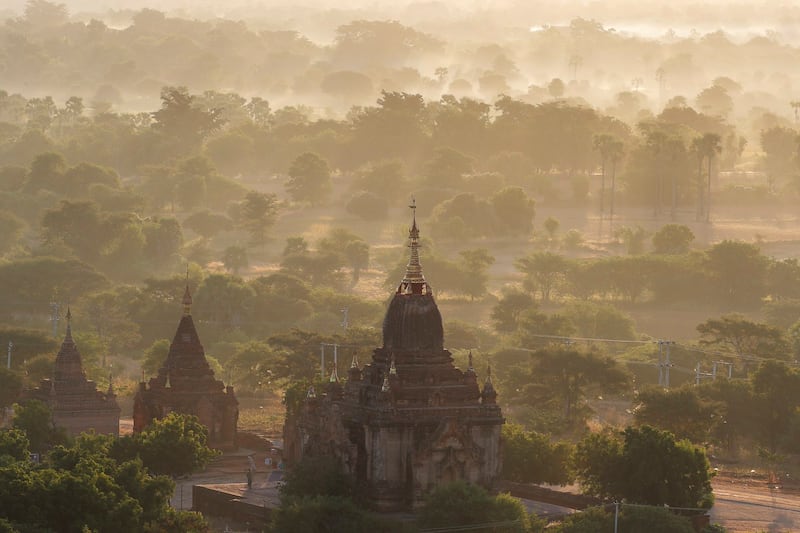Heavy rains and flooding during the recent rainy season caused damage to about 1,900 pagodas at the UNESCO World Heritage site of Bagan, and many of the ancient Buddhist temples are now at risk of collapse, an archaeologist told Radio Free Asia.
The deterioration over the last few months to the temples – many of which were built between the 10th and 13th centuries – follows several years of inadequate preservation work, according to Thura Aung, former secretary of the Myanmar Archaeology Association.
Additionally, the 2021 military coup d’etat and subsequent fighting between factions in the region has left the Bagan Archaeological Zone understaffed, he said.
“Currently, the staff at Bagan’s Archeological Department is insufficient, and there is no plan to address the shortage,” he said. “Bagan is a vast area with numerous temples, but the available workforce is inadequate. There is no strategy in place to resolve the staffing issue.”

Bagan’s soaring spires and iconic Buddhist pagodas and temples, a main attraction for Myanmar’s tourism industry, are popular with religious pilgrims and tourists who scale the monuments to watch the sun set.
A major earthquake in 1975 severely damaged more than half of the area’s pagodas and temples and toppled the notable Buphaya Pagoda, which broke apart and fell into the Irrawaddy River.
Restoration work was carried out in the 1990s when a previous military junta ruled Myanmar, but the work was criticized by art historians and preservationists worldwide for its use of modern materials and scant adherence to original architectural styles.
In 1996, Myanmar officials put in an initial application for the Bagan archeological site and pagodas to become a UNESCO World Heritage Site. The bid was rejected, apparently because of poor management strategies and improper restoration work.
Bagan was finally added to the World Heritage list in 2019. But much of Bagan’s preservation oversight fell away after the 2021 coup when teams from France, South Korea and Japan withdrew.
“In the past, the pagodas were constructed with tightly compacted, well-baked bricks, pressed layer by layer with great care, which is why they withstood time,” a resident of Bagan who has worked on pagoda restoration told RFA.
“If a collapse were due to age, it would be understandable,” he said. “But now, the temples are collapsing before their time, and this is due to the methods, and most importantly, the quality of the materials used.”

Maintaining the temples requires the proper baking of bricks and ensuring correct proportions, he said. Workers must also seal ramps and terraces with water-resistant materials and remove any wild plants that grow on the pagodas.
‘Cement is prohibited’
A report released by the military junta’s Ministry of Information on Sept. 13 acknowledged that stairways, brick walls and decorated archways have recently deteriorated at noted temples such as Shwezigon, Thatbyinnyu and Htilominlo.
Additionally, the lower terraces and sections of platforms have collapsed at two pagodas in the Hnetpyittaung pagoda group. Damage was also found at three other nearby pagodas, according to the report.
RELATED STORIES
[ Construction in ancient city of Bagan goes unchecked under juntaOpens in new window ]
[ Myanmar President Visits Bagan to Survey Quake-Damaged PagodasOpens in new window ]
These temples are currently being repaired, said Kyaw Myo Win, director of the Bagan branch of the junta’s Department of Archaeology.
“Since becoming a World Heritage Site, all restoration work has adhered to traditional principles. Even the use of cement is prohibited,” he said. “We recreate the original mortar using the same traditional mixing methods, and when we use bricks, they match the original size and color.”

But according to Thura Aung, there is no consistent practice in place for maintaining the pagodas. Modern, readily available materials are too often being used for repairs, he said.
“The claim that they are preserving the original method is just on paper,” he said. “In reality, it’s being revised without maintaining its true authenticity.”
Critics have also cited an increase in construction projects in the ancient city that are undertaken without heritage impact reports and have disrupted irrigation systems and water drainage in the increasingly urbanized landscape.
Last week, junta leader Senior General Min Aung Hlaing visited Bagan to inspect recent repairs aimed at preventing future flooding from the zone’s lakes and reservoirs, several junta newspapers reported.
Translated by Kalyar Lwin. Edited by Matt Reed.
